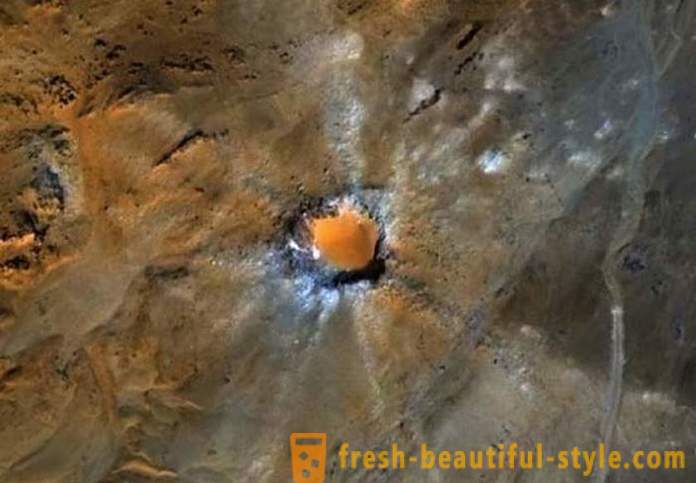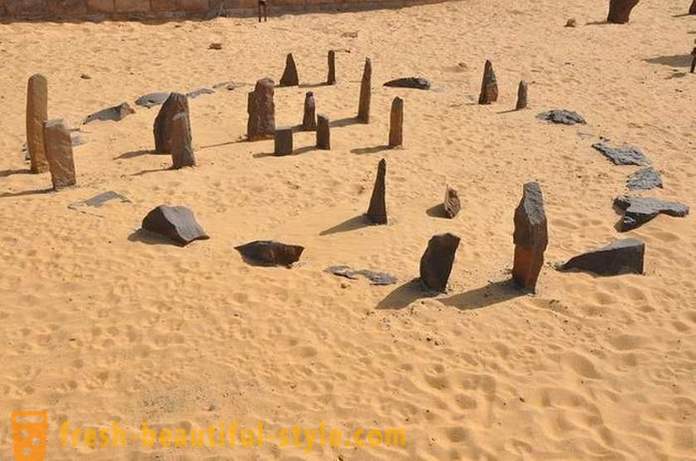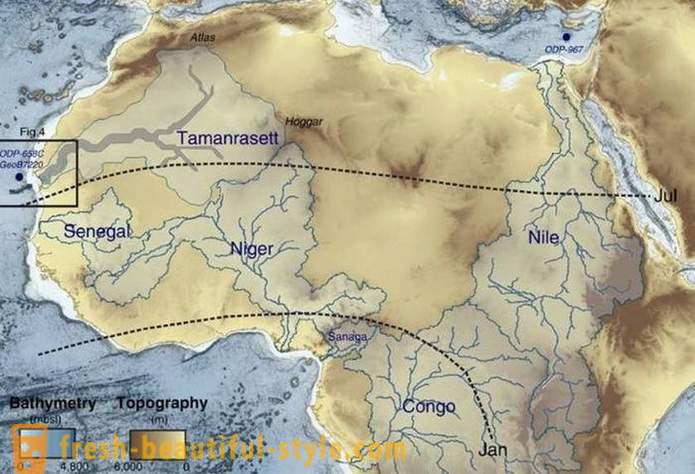Secrets of the Sahara
Sands of the Sahara for centuries absorbed the animals, people and entire cities. It is the largest desert in the world, and those who had been careless enough to get lost on its endless sandy plains were lost forever. It is known that in the ancient world armies tried to cross the desert, after which they are no one else has ever seen. Only now, with the help of modern technology, people are beginning to comprehend the mysteries of the Sahara, which has accumulated a surprising number of ...
1. Lost Fortress

The satellites have allowed researchers to look under the crown of thick virgin jungle and penetrate the heart of the most inhospitable deserts - and all this without even getting up from the easy chair. In 2010, satellites have discovered the remains of more than 100 fortresses belonging to the ancient people "Garamantes" in Libya.
The area was pretty well mapped during oil exploration (when the representatives of the oil companies were looking for a place to drill wells), so archeologists were able to scan the satellite images for the presence of the characteristic features of the walls.
Later, researchers have been able to personally confirm that the facilities were really built Garamantes, although the expedition had to be abandoned because of the revolution in Libya (the overthrow of Muammar Gaddafi). During the heyday of Garamantes (about the second century BC to the seventh century BC) the territory in which they lived, it was already an incredibly dry.
To cultivate the land, they built underground channels, which provides water to the ancient water bodies. When these water sources have dried up, the fields dried up, and buried under the sand Sahara remains of fortresses and villages.
2. meteorites and craters

The Earth has always been subjected to bombardment by meteorites from outer space. Most of them are harmless burned in the atmosphere, leaving nothing but streaks of light in the sky. Others reached the ground and provided a truly devastating effect.
Since most of these accidents happened in the distant past, the craters left by a meteorite impact, often ignored because erosion or plant growth conceal them. However, in the deserts can still see the "scars" of the strikes, "visitors from outer space."
For example, Kamil crater 45 meters wide in the south-western Egypt - the crash site of an iron meteorite about 5,000 years ago. Kamil around the crater were found scattered on the sand fragments of the meteorite itself, a terrible blow shattered on the ground.
And it's not a single discovery. Almost a fifth of all discovered meteorites was found in the Sahara. Only snow of Antarctica are more "fertile" in the ancient meteorites.
3. Libyan desert glass

Even when the remains of meteorites and their craters disappeared thousands of years later, other may remain traces of cosmic collisions.
About 29 million years ago a meteorite fell to earth, and at the same time freeing up enough energy to melt quite a vast area of the Libyan desert, turning the sand into sheets of thin green glass. The crater left by this explosion has not yet been found, but there is still a lot of desert glass, which occurs even in very unexpected places.
When Howard Carter opened the tomb of Tutankhamun, he discovered among the treasures jeweled bib belonging to the dead Pharaoh. In its center a sacred scarab beetle was built, carved out of green glass. Probably, the Egyptians had no idea about the origin of the glass, which they used, but, interestingly, was found another artifact made from the other material. One of the daggers in the tomb was made from meteoric iron.
4. Stones Nabta

wherever there is water in the desert around there is always life. When people lived near Nabta Playa in southern Egypt, 9000-6000 years ago, the area was subjected to annual floods, which resulted in the lake was formed. Neolithic tribes came to this place to feed and water their animals.
These people not only survived there, but also developed a unique culture of sacrifice. Archaeologists have found remains of cows, sheep and goats in the ritual burial. About 6,000 years ago, people in Nabta installed large stone blocks in a circle.
Scientists believe that this stone circle of Stonehenge is older than 1,000 years, is the earliest known astronomical structures. Until the debate as to what the name indicates, this circle, but one researcher claims that it coincides with the position of the belt of Orion, as he was seen 6000 years ago, is still underway.
5. Lost River

The Sahara desert is not always there. As the climate changed over millions of years, sand the border have also changed. Scientists are looking for evidence of the existence of water on Mars in ancient times, they have turned their attention to the history of the Sahara.
Studies have shown that once flowed the river from the Sahara to the 12th-largest watershed in the world. Remains of the river in Mauritania were observed when the underwater canyon off the coast, which was broken by the river was discovered. Also found in unexpected places river sediment. Finally confirmed the presence of the lost river, called Tamanrasett, via satellite. Researchers continue to look for further information about the reservoir, which may have dried up just 5,000 years ago.
6. Whales

Not only the river disappeared under the sands of the Sahara. For a very long time what was once an ocean, it was one of the driest places on Earth. The Wadi Al-Hitane in Egypt, you can find evidence of long-vanished Tethys Ocean. This place is known as the Whale Valley, it is one of the best places to detect whale fossils.
When the ancestors of modern whales died in the sea 37 million years ago, and their bodies were covered with a thick layer of sediment. When the crust has risen, their former home turned into the ground. Today, paleontologists studying the skeletons of 15 meters in length, as well as entities with which whales live in the sea. Next to the whale bones teeth are very large sharks have been found.
7. Mahimozavr Rex

The sea has always been home to monsters. About 120 million years ago, 9-meter-long crocodile Machimosaurus rex lived in what is now the Sahara desert. Mahimozavr Rex - the largest of the crocs lived in the ocean. The area where once lived this reptile was probably a huge lagoon, stretching up to the Tethys Ocean. There Mahimozavr hunting sea turtles and fish.
Probably, this reptile also devoured the bodies of larger creatures. It may seem ironic that so many sea life was found in the Sahara, but in fact there paleontologists make so many discoveries precisely because the desert is extremely inhospitable to all living things. Given that there are no plants and soil, scientists can often find amazing discoveries right under your feet.
8. Spinosaurus

Continuing the theme of maritime discoveries made in the desert, it is worth mentioning Spinosaurus - the largest carnivorous dinosaurs ever discovered by scientists. Who lived 95 million years ago, Spinosaurus (aka Spinosaurus aegyptiacus) had a growth of about 7 meters and a length of 16 meters, which is higher than that of the more famous Tyrannosaurus rex.
Spinosaurus was not at all similar to its better known rival. He had a huge "sail" of the bones sticking out of his back, and a number of other "tools", which put scientists in a deadlock.
It is now believed that the Spinosaurus - the only known semi-aquatic dinosaur. Since bone originally discovered Spinosaurus were destroyed during the Second World War, but in 2014 in Morocco were able to detect other types of fossils and the researchers were finally able to explore the Spinosaurus.
Some of the evidence indicating that the Spinosaurus lived partly in water, - its long, flat feet were well adapted for rowing, and his nostrils were located high up on the face, so the dinosaur could breathe, even when most of the water. Surely the vast view of the approaching sail on its back, suggesting the inhabitants of ancient seas around the same horror as the shark fin today.
9. The Fighter World War II Curtiss P-40 Warhawk Kittyhawk

June 28, 1942 Sergeant Dennis Copping flew the damaged plane Kittyhawk P-40 on the British base in the desert for repair. Somewhere in the middle of the road he disappeared. Only in 2012 the remains of the aircraft were found when oilman stumbled upon them.
The aircraft remained largely intact, and he was taken to El Alamein Museum, which was restored. Interestingly, no trace of Dennis coping were found. His fate - another mystery, which keeps the Sahara.
10. Skeletons Gobero

Paul Sereno has already figured in this list, since it was part of the team that found the fossils in 2012 Spinosaurus. It was during one of his trips for dinosaur bones, he accidentally found the greatest human cemetery in the Sahara.
Gobero site in Niger has been inhabited for about 10,000 years ago, and once it buyala lush greenery. Remains of fish, crocodiles and other animals mixed with the bones of men. Many of the discoveries of just sticking out of the sand.
In two years, the excavation was found about 200 human burials of two separate periods of habitat separated by more than 1000 years. These traces left Kiffiyskaya Tenerianskaya and culture. Ornaments made of bones and bone arrowheads were found near the harpoons, which were used for hunting in the nearby waters.
Many of the graves were very unusual. One man was buried with his head, put in a pot, and the other rested on the remains of a turtle shell. Perhaps we will never know exactly how these people lived and died. Sugar does not want to reveal all their secrets.













































